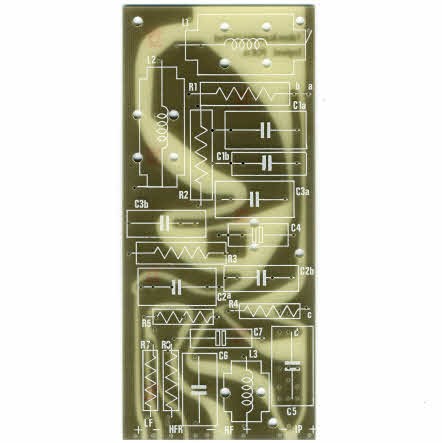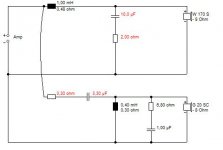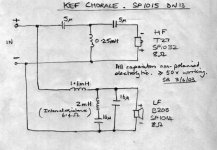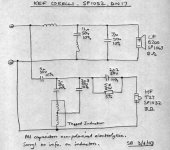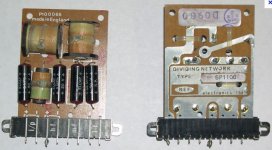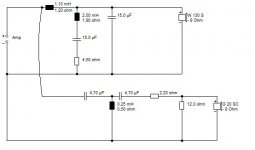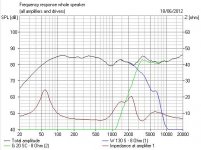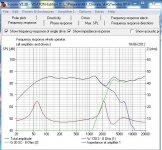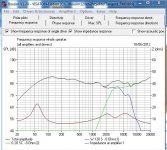Inherited these from my dad a few years ago and spent some time replacing the drivers and tweeters as they were knackered. (was told the drivers that were fitted at the time were Elac 8", but there were no markings and they weren't a matched pair anyway) The original tweeters were goodmans DT4 silk domes. I replaced the main drivers with a matched pair of KEF B200 SP1063A and the tweeters with a pair of Seas prestige H1280-06 22TFF tweeters. I reused the original crossovers that were there. The cabinets are 24L or 0.85cu.ft and ported with a 52x155mm port. Having read the specs on the kef drivers I've listened to them with the ports plugged. I have also tried unplugged too and found little difference. (although I've left them unplugged) Overall I find them quite pleasing to listen to, however I don't know if there are any improvements that I could make to them.
This is how they look now.
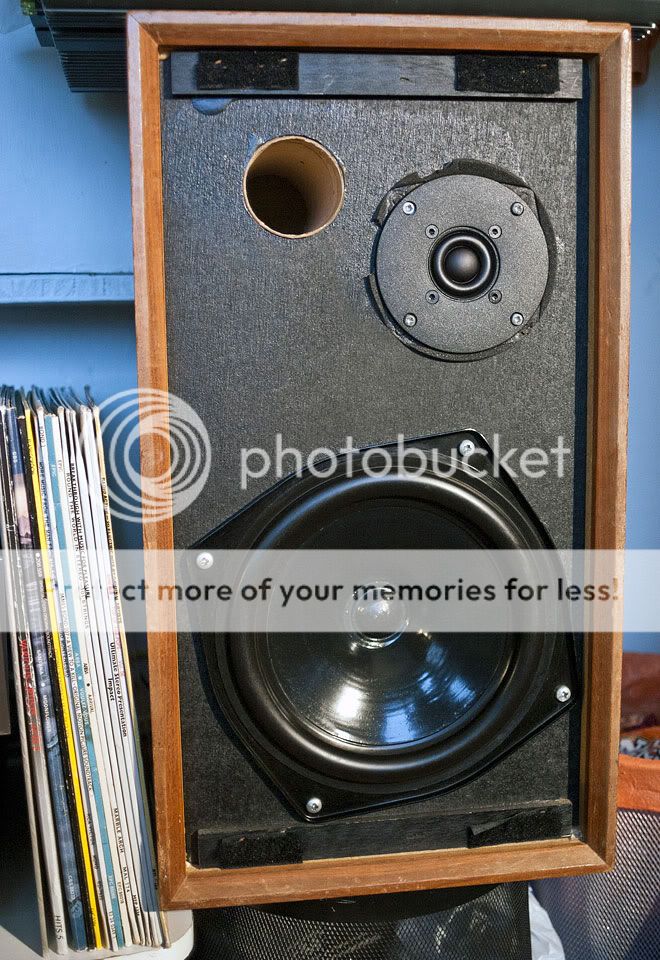
The crossover AFAIK is 1st order for the LF/midrange and 2nd order for the HF. The capacitor is 4.7uF 63V. I don't yet know the value of any of the other components. (I'd rather not have to dismantle them to find out)
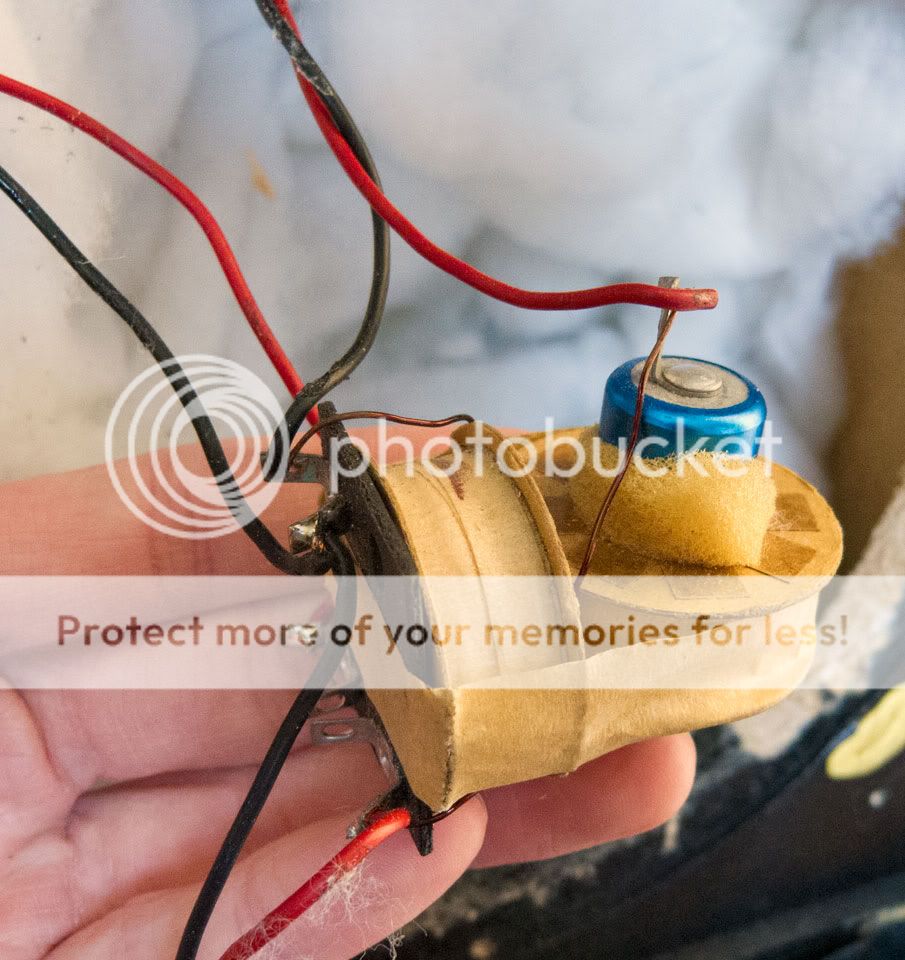
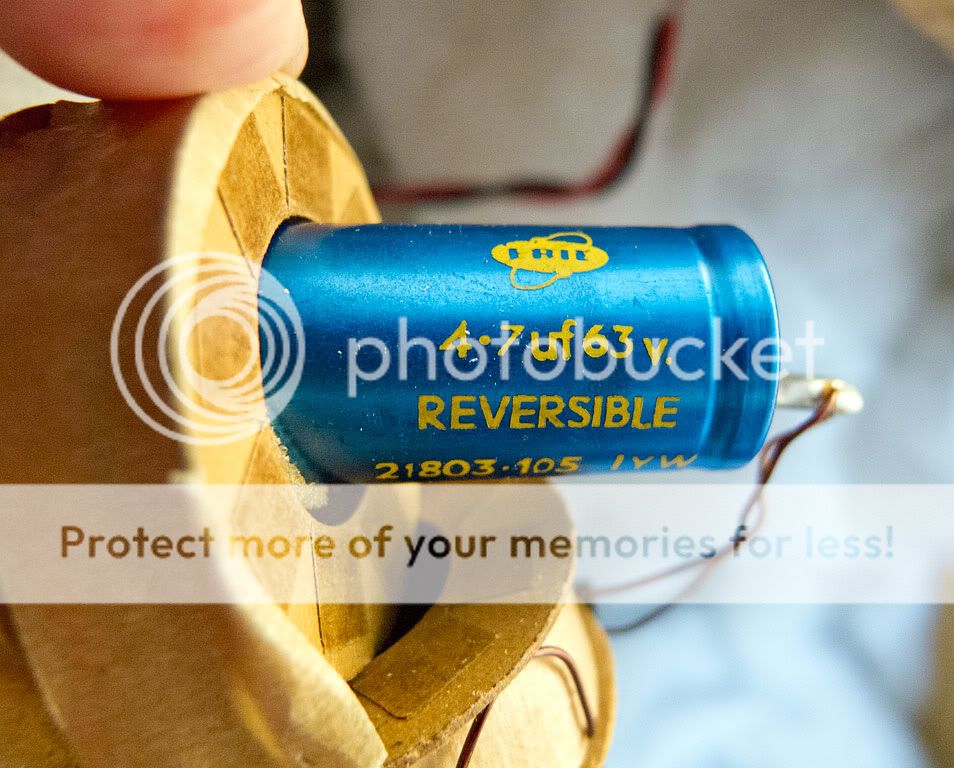
I'm guessing a custom crossover for them might be better suited. If anyone can rough guess (or knows) the crossover component values can plot the response for me, that would be a great bonus.
This is how they look now.

The crossover AFAIK is 1st order for the LF/midrange and 2nd order for the HF. The capacitor is 4.7uF 63V. I don't yet know the value of any of the other components. (I'd rather not have to dismantle them to find out)


I'm guessing a custom crossover for them might be better suited. If anyone can rough guess (or knows) the crossover component values can plot the response for me, that would be a great bonus.
I got some ClarityCap ESA replacements for the original erie bipolars. (cheap enough and supposedly a good performer, didn't fancy those ridiculously expensive mundorf silver items)
I measured the actual value of the originals and they came up as 6.4 and 6.5uF. The new ones are measuring a whisker over 4.7uF. There is definitely a difference in the way they sound, I reckon its a tad brighter which is probably down to the loss of the capacitor's ESR.
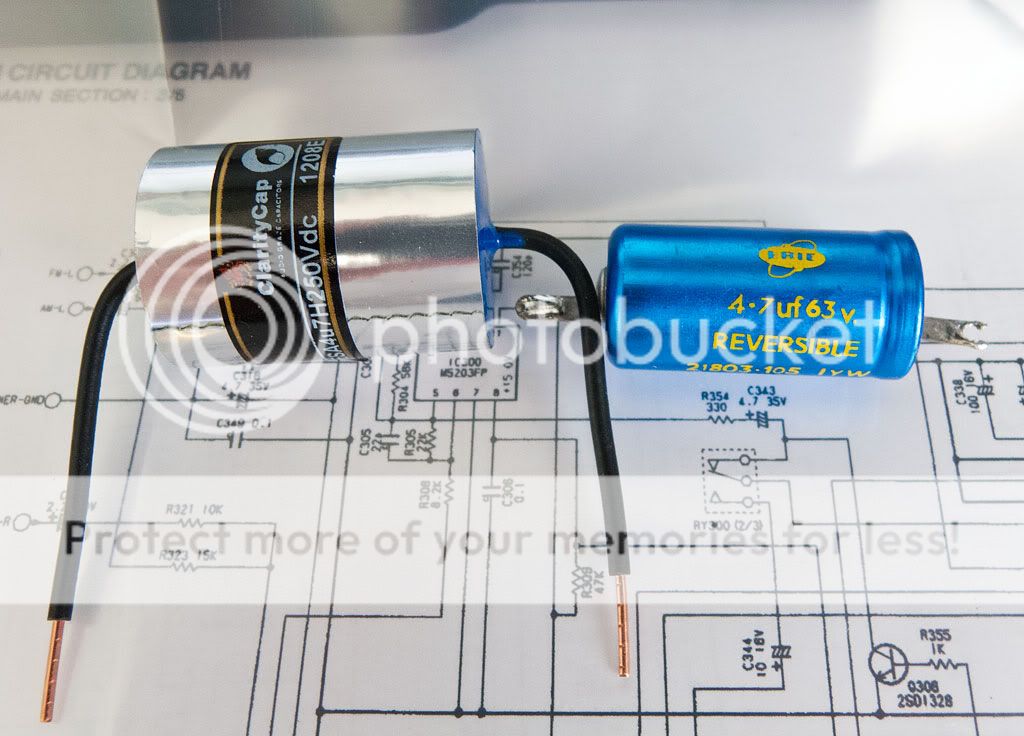
The B200 is an SP1063. and the Tweeter specs are here.
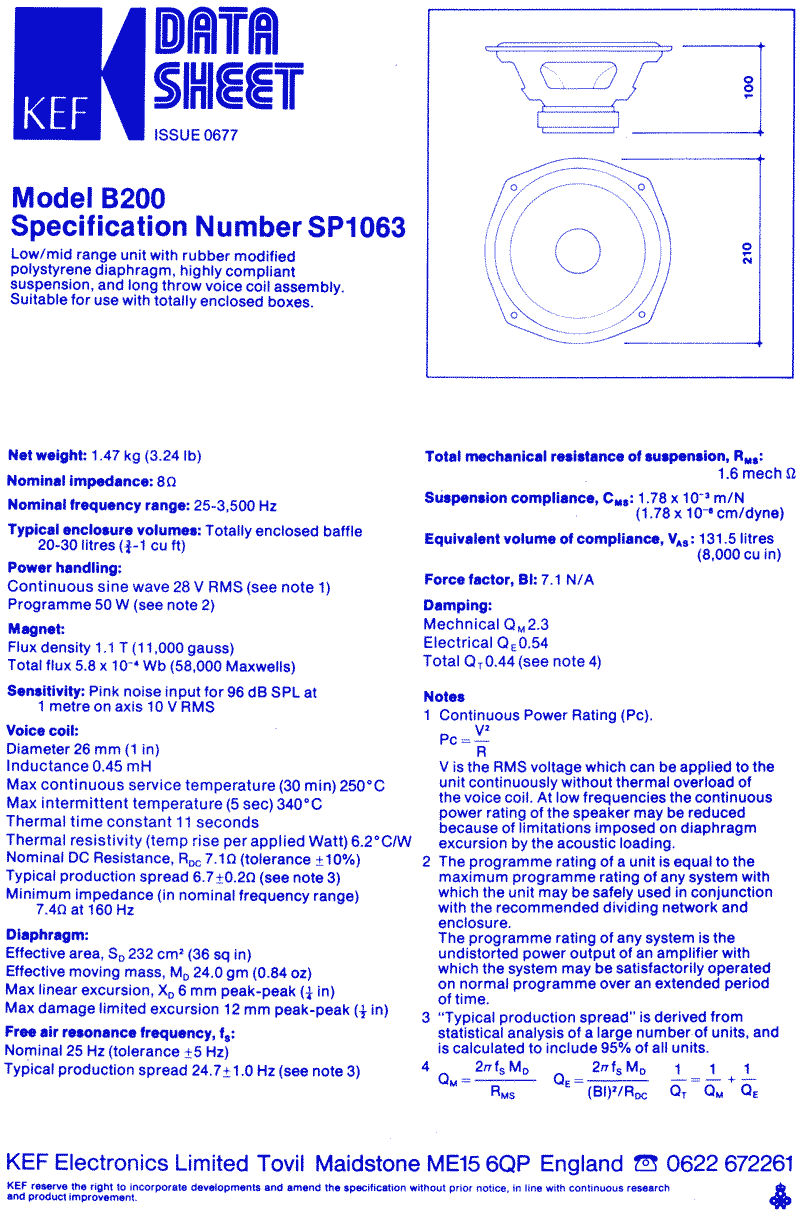
As far as i can tell this is how the crossovers are wired up. (inductors are unknown values as i have no inductance meter)

Since my speakers are very similar in design to the KEF chorale would it be beneficial to replace/upgrade these crossovers to something like the KEF chorale crossover kits they have on falcon acoustics?
These are the chorales: (They don't use the SP1063 unit, AFAIK it's an SP1014 and T27 - SP1032)

I measured the actual value of the originals and they came up as 6.4 and 6.5uF. The new ones are measuring a whisker over 4.7uF. There is definitely a difference in the way they sound, I reckon its a tad brighter which is probably down to the loss of the capacitor's ESR.

The B200 is an SP1063. and the Tweeter specs are here.

As far as i can tell this is how the crossovers are wired up. (inductors are unknown values as i have no inductance meter)

Since my speakers are very similar in design to the KEF chorale would it be beneficial to replace/upgrade these crossovers to something like the KEF chorale crossover kits they have on falcon acoustics?
These are the chorales: (They don't use the SP1063 unit, AFAIK it's an SP1014 and T27 - SP1032)

Last edited:
The original 8" driver was a paper cone unit from the O.E.M. range of Goodmans speakers. The crossover network should have the inductor in parallel across the tweeter .The tweeter needs an 'L' pad of -4dB to bring its level down to match the B200,s sensitivity;it has nothing to do with capacitor ESR.The Bextrene cone has problems in the mid-range and while correction networks may help to minimise the effects,maybe a better bass/mid range driver could be your next step.Meanwhile,since the cabinet is too small for the KEF bass driver it may help to add some wadding to the port tube.
I think i've listened to them as they are for a bit long and as such quite used to the brightness. Setting the parametric EQ up to knock 2k and up down by 4dB it seems a touch muffled compared to what i'm used. I've had a look and this is what an L-pad calculator suggests.
For -4 dB
Resistors
R1 = 2.21 Ohms - can get 2.2
R2 = 10.26 Ohms - can get 10.
11W should be sufficient for a tweeter? (50W luxman amp powering it)
For -4 dB
Resistors
R1 = 2.21 Ohms - can get 2.2
R2 = 10.26 Ohms - can get 10.
11W should be sufficient for a tweeter? (50W luxman amp powering it)
Last edited:
You've got your work cut out for you, setting these up by ear. 
You can't realistically notch any nasties on the woofer, and really falcon acoustic's Chorale filter is made for a different B200 driver, so forget it. People do get decent results without the notch though, so there's hope.
At simplest you can try your tweeter attenuator on the Re= 5 ohm SEAS unit. And a rolloff capacitor on the woofer. Could be anything between 5 and 12uF with a little optional 2 ohm resistor to damp it a bit, I'd reckon. I've roughed up a circuit that incorporates some 4dB of tweeter attenuation and a calculated rolloff Zobel for the SEAS. Might be OK. 3.3uF for the tweeter is just a bit gentler than 4.7uF, but not a big deal.
BTW, your tweeter filter looks as in my diagram. What you've sketched would fry the tweeter with bass.
You can't realistically notch any nasties on the woofer, and really falcon acoustic's Chorale filter is made for a different B200 driver, so forget it. People do get decent results without the notch though, so there's hope.
At simplest you can try your tweeter attenuator on the Re= 5 ohm SEAS unit. And a rolloff capacitor on the woofer. Could be anything between 5 and 12uF with a little optional 2 ohm resistor to damp it a bit, I'd reckon. I've roughed up a circuit that incorporates some 4dB of tweeter attenuation and a calculated rolloff Zobel for the SEAS. Might be OK. 3.3uF for the tweeter is just a bit gentler than 4.7uF, but not a big deal.
BTW, your tweeter filter looks as in my diagram. What you've sketched would fry the tweeter with bass.
Attachments
Why use a tapped inductor? What does that do?...BTW, your tweeter filter looks as in my diagram. What you've sketched would fry the tweeter with bass.
The (obsolete) idea of tapped inductors is they include a coil and an attenuator all in one. But I haven't got a clue what KEF are doing there in the Corelli. It makes no sense to me!Why use a tapped inductor? What does that do?
Looking at the datasheets for the SP1063 and the SP1014, there isn't much difference between them, The 22TFF tweeter doesn't seem greatly different to the T27 either. Could i use the falcon PCB (they suggest it can be used for various B200/T27 combinations) and use my own choice of components to make a more suitable unit?
Looking at the datasheets for the SP1063 and the SP1014, there isn't much difference between them, The 22TFF tweeter doesn't seem greatly different to the T27 either. Could i use the falcon PCB (they suggest it can be used for various B200/T27 combinations) and use my own choice of components to make a more suitable unit?
I think you're RIGHT there, Kei. Very Similar!
Wouldn't surprise me if KEF sold off out of spec SP1063 as SP1014!
Below is the Kefkit1 SP1106 crossover, aka known as the Chorale. I see the same components as the Chorale schematic I posted earlier. You get the notch too.
Attachments
kef b200 with t27 tweeter
Tangent Speakers TM-1
I atually own a pair of tm3's and they sound very good indeed, they have a pure sound no other speakers i have heard has, which i cannot define.. not much deep bass though from a 8inch sealed box....
but anyway,
theres a xover schemetic there, that might be of use for comparative reasons.
what notches.. who cares, if your tweeter is like the t27 you shouldnt have any huge problem ending up with a nice sounding speaker. the odd notch in the woofers responce will be nothing compared to the peeks and nulls of a room. adding notch filters just complicates the design, and the extra components probs arnt good for the sound, + its a lot of effort
probs should attuete the tweeter a bit though
the tweeter seems happy to play quite low for a tweeter, maybe a 2.5k xover would be better
Tangent Speakers TM-1
I atually own a pair of tm3's and they sound very good indeed, they have a pure sound no other speakers i have heard has, which i cannot define.. not much deep bass though from a 8inch sealed box....
but anyway,
theres a xover schemetic there, that might be of use for comparative reasons.
what notches.. who cares, if your tweeter is like the t27 you shouldnt have any huge problem ending up with a nice sounding speaker. the odd notch in the woofers responce will be nothing compared to the peeks and nulls of a room. adding notch filters just complicates the design, and the extra components probs arnt good for the sound, + its a lot of effort
probs should attuete the tweeter a bit though
the tweeter seems happy to play quite low for a tweeter, maybe a 2.5k xover would be better
Last edited:
Good contribution there, Waveinform. 
The notch is quite a deep one at 900Hz. About 3-6dB. Worth doing it if you can, I'd reckon. A bit of progress anyway:
The 1.1mH woofer coil is doing quite a big bafflestep which boosts bass. 16uF looks like the value to go for with that one, even without the notch. The notch doesn't interact with the rolloff.
Matching the SEAS tweeter is NOT trivial though. That 3rd order highpass is quite steep and sensitive to the exact tweeter. Be much easier on a second order really. But overall, it looks like you try and get the woofer right and then line up the tweeter as a plan. Personally I'd use a much smaller woofer coil (Le for the woofer is a mere 0.45mH), a different capacitor and wallmount these.
The notch is quite a deep one at 900Hz. About 3-6dB. Worth doing it if you can, I'd reckon. A bit of progress anyway:
An externally hosted image should be here but it was not working when we last tested it.
The 1.1mH woofer coil is doing quite a big bafflestep which boosts bass. 16uF looks like the value to go for with that one, even without the notch. The notch doesn't interact with the rolloff.
Matching the SEAS tweeter is NOT trivial though. That 3rd order highpass is quite steep and sensitive to the exact tweeter. Be much easier on a second order really. But overall, it looks like you try and get the woofer right and then line up the tweeter as a plan. Personally I'd use a much smaller woofer coil (Le for the woofer is a mere 0.45mH), a different capacitor and wallmount these.
The response characteristics from the B200 seem to be very good as it stands, I don't think there would be a need to put a notch filter in, though TBH there is only one way to find out if it is a good idea or not. Strange that they used an SP1014 in those tangents considering the datasheet suggests the SP1054 is more suitable to reflex applications. (with roughly the volume of those TM1 cabinets) The room where these speakers operate is fairly compact, which seems to improve their low end response, there is also little in the way of soft furnishings (no curtains), so reflections are probably quite high.
Which is another way of saying your room acoustics are so hopeless you won't hear the difference.The response characteristics from the B200 seem to be very good as it stands, I don't think there would be a need to put a notch filter in, though TBH there is only one way to find out if it is a good idea or not. Strange that they used an SP1014 in those tangents considering the datasheet suggests the SP1054 is more suitable to reflex applications. (with roughly the volume of those TM1 cabinets) The room where these speakers operate is fairly compact, which seems to improve their low end response, there is also little in the way of soft furnishings (no curtains), so reflections are probably quite high.
You're in a happy place with that KEF Chorale design. The notch does require 6.4 ohms of resistance total in the LC filter circuit, which you may need to make up with a wirewound resistor addition to the coil and capacitor. Otherwise the Q of the notch will be wrong. The Chorale is a 20-30L closed box design at heart. Probably best slightly away from a wall as it stands, but you are the best judge of that..
What you find with speakers is that you get them about right and everything comes into focus. That notch is a refinement that you will only hear when everything else is right too.
For sure using a woofer on just a coil to filter is about as cheap and bad as it gets. You end up with terrible overlap with the tweeter that makes for colouration and harshness, though bextrene might get away with it better than most cones. Your best next step is to add the rolloff capacitor to the woofer. 10uF and 1 ohm in series would be a good start. You'll get much better midrange.
An externally hosted image should be here but it was not working when we last tested it.
So I assume that this would be the crossover design to go with. (same as drawn in your image) Would it be of any benefit lowering the crossover point like WaVeInFoRm suggested?
A closer look at the falcon crossover gives this info:
KEF B200A/T27(equiv.to DN13 SP1015 but with higher power rating)(SP1106) (single)
J.Mathers, HiFi News, June 1972 (Used in KEF Chorale and KEFkit1. See also 37K)*
M.Colloms, Pop. HiFi, Dec. 1972 mini ) High Power (PCB2)
*We have a Chorale cabinet upgrade sheet. Add a ‘stand’ sub-chamber and get +5dB below 45Hz.
At the same time upgrade the network or replace with our No. 37K with aB HF section (SASE)
I think the room is probably the main let down due to its size. The speakers are about 8" from the wall and they are about 19" above the floor.
Last edited:
I've drawn up a circuit that follows the SP1015 design and incorporates the necessary HF attenuation for the SEAS 22TFF tweeter. Not certain if the parallel resistance can go in series with the 0.25mH inductor and if the series resistance can go in parallel with one of the 5uF capacitors though.
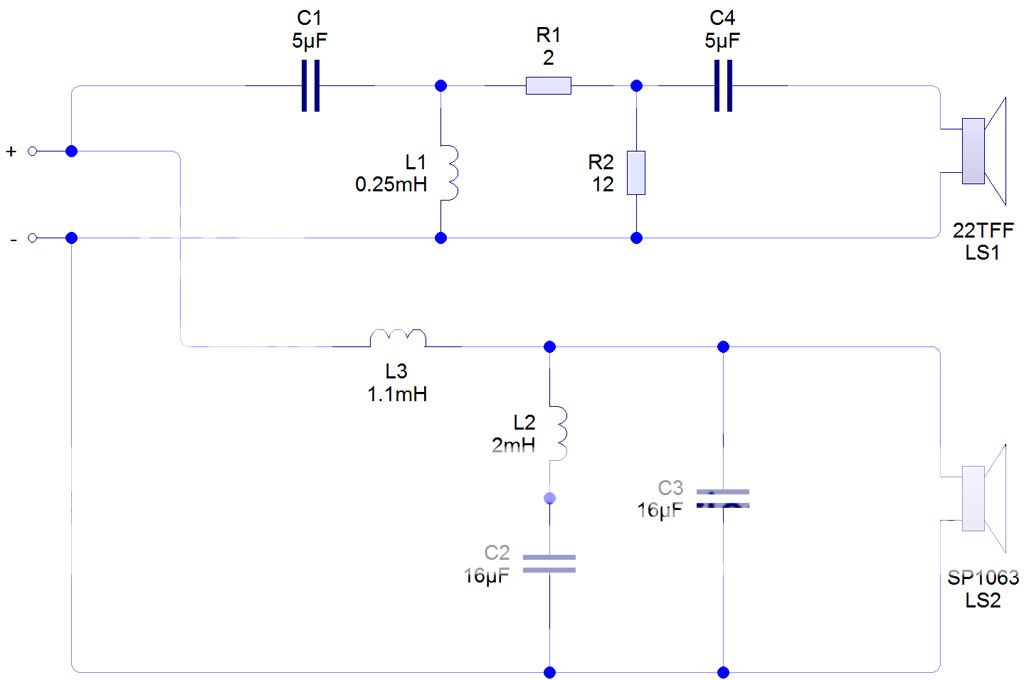

Curiously that models rather well, but the tweeter section is a bit odd. It's a very good thing to have the attenuator right in front of the tweeter to get a smooth sound. 
You DO need 6.4 ohms resistance in the 6dB woofer notch, or it becomes 12dB, which is excessive. I found this whole thing worked best on phase with non-polar capacitors and a quite resistive 0.25mH coil around 1.5 ohm. It cures the peak at 3.5kHz on the high pass. The KEF filter also works well with losing the second 4.7uF capacitor and going second order, but KEF are such good engineers, that the peak may align with a dip on the woofer for all I know and the crossover is an essential part of the very good KEF sound. BTW, don't take the sim too seriously, I'm using different drivers.
Overall we come full circle back to that falcon acoustics chorale kit, which will doubtless work well with the attenuated SEAS and maybe a tweak here or there. It's gonna be a lot tidier than trying to build it yourself.
KEF CHORALE IMPROVED CROSSOVER No. 37K c/w aB HF SECTION
You DO need 6.4 ohms resistance in the 6dB woofer notch, or it becomes 12dB, which is excessive. I found this whole thing worked best on phase with non-polar capacitors and a quite resistive 0.25mH coil around 1.5 ohm. It cures the peak at 3.5kHz on the high pass. The KEF filter also works well with losing the second 4.7uF capacitor and going second order, but KEF are such good engineers, that the peak may align with a dip on the woofer for all I know and the crossover is an essential part of the very good KEF sound. BTW, don't take the sim too seriously, I'm using different drivers.
Overall we come full circle back to that falcon acoustics chorale kit, which will doubtless work well with the attenuated SEAS and maybe a tweak here or there. It's gonna be a lot tidier than trying to build it yourself.
KEF CHORALE IMPROVED CROSSOVER No. 37K c/w aB HF SECTION
Attachments
Last edited:
I am currently using my TM-3 Speakers, (that use the same woofer) I checked the responce in room, using a sine wave generator, and my ears and brain and hopefully my conciousness. At and around the 900hz frequency and there simply is no noticaple drop in amplitude...
900hz is the same volume as 500hz, by my ears... unless that null is a product of the crossover or your box or the simulation program, and not the driver itself
Just like all the other frequencys, It gets equally stronger and weaker. as you move in 3d space
900hz is the same volume as 500hz, by my ears... unless that null is a product of the crossover or your box or the simulation program, and not the driver itself
Just like all the other frequencys, It gets equally stronger and weaker. as you move in 3d space
Last edited:
Would it be of any benefit lowering the crossover point like WaVeInFoRm suggested?
I think the room is probably the main let down due to its size. The speakers are about 8" from the wall and they are about 19" above the floor.
Disance from floor should be ok. distance from walls is not really ideal
Cardas Audio
Like this is good, but u can invertreverse it so the distance from the walls is greater that the distance to the rear wall, using the same rectangle, to ensure all 3 distances differ.
In regards to the lower Xover point. I honestly dont know. I ony metioned it because your tweeter probubly could go lower than the T27 that the woofer was often paired with. It may be an improvement. System 7 should know
HaHa, you're the typical diyaudio dog who won't let go of a bone! 
The Tangent TM1 uses less bass rolloff than the KEF Chorale, so the resonance is less marked. I'm using a 5" paper bass here which has a strong peak at 1300Hz that usually needs treatment with my preferred LCR parallel trap. KEF often used traps with the B200 too. The Tangent puts a 27 ohm resistor alongside the 0.392mH tweeter coil to damp the tweeter crossover peak too.
It's odd but true that drivers seem to bend their frequency response at the resonant points. I have noticed this with cone tweeters too. Odd and interesting. Steep rolloff causes more problems than gentle rolloff in general.
Oh, FWIW Kei, I think you are stuck with the 3.5kHz crossover point. I wouldn't like to guess how to modify the Chorale woofer section.
The Tangent TM1 uses less bass rolloff than the KEF Chorale, so the resonance is less marked. I'm using a 5" paper bass here which has a strong peak at 1300Hz that usually needs treatment with my preferred LCR parallel trap. KEF often used traps with the B200 too. The Tangent puts a 27 ohm resistor alongside the 0.392mH tweeter coil to damp the tweeter crossover peak too.
It's odd but true that drivers seem to bend their frequency response at the resonant points. I have noticed this with cone tweeters too. Odd and interesting. Steep rolloff causes more problems than gentle rolloff in general.
Oh, FWIW Kei, I think you are stuck with the 3.5kHz crossover point. I wouldn't like to guess how to modify the Chorale woofer section.
Attachments
Last edited:
- Home
- Loudspeakers
- Multi-Way
- Goodmans Minister
